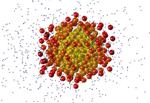Other

“HEIDELBERG PHYSICISTS DEMONSTRATE THE COEXISTENCE OF SUPERFLUIDS IN ULTRACOLD ATOMIC CLOUDS Two superfluids can exist at the same time in ultracold atomic clouds. Until now, their coexistence could not be observed experimentally. Now, however, physicists from Heidelberg University have demonstrated …

“Researchers see application in future quantum technologies The fundamental laws of physics are based on symmetries that, among other things, determine the interactions between charged particles. Using ultracold atoms, researchers at Heidelberg University have experimentally constructed the symmetries of quantum …

“It is crucial for photovoltaics and other technical applications, how efficiently energy spreads in a small volume. With new methods, the path of energy in the nanometer range can now be followed precisely. Plants and bacteria lead the way: They …

““3D Matter Made to Order” Cluster of Excellence of KIT and Heidelberg University Starts and Focuses on Printed Three-dimensional Design Structures Additive processes, such as 3D printing, can be used to produce nearly any structure, even in the nanoscale. Depending …

“Polymer pelts made of the finest of fibers are suitable for many different applications, from coatings that adhere well and are easy to remove to highly sensitive biological detectors. Researchers at Karlsruhe Institute of Technology (KIT) together with scientists in …

“Scientists found that relatively slow electrons are produced when intense lasers interact with small clusters of atoms, overturning current theories. Intense laser cluster interactions occur when small clusters of atoms, nanometres (billionths of a metre) in size, are struck with …

“Two researchers at Heidelberg University have developed a model system that enables a better understanding of the processes in a quantum-physical experiment with ultracold atoms. Using computer-assisted methods, Prof. Dr Sandro Wimberger and David Fischer from the Institute for Theoretical …

